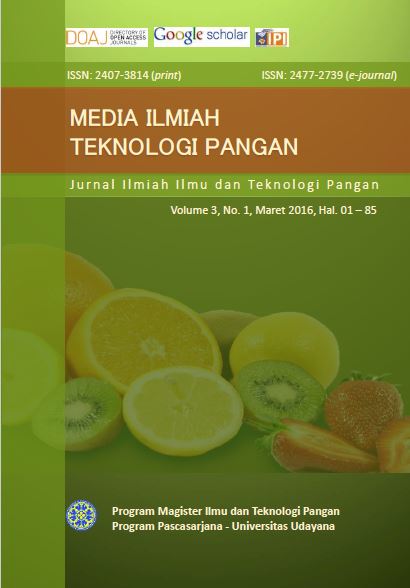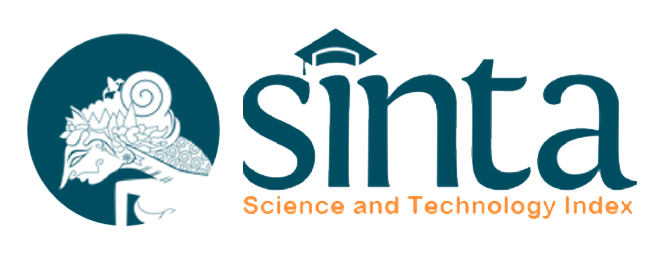Antioxidant Activity of Lactobacillus spp as for Development of Antioxidantive Probiotic
Abstract
Probiotics are live microorganisms which when administered in adequate amount confer health benefit to the host. Our previous studies revealed that Lactobacillsus spp isolated from infant feces potential to be developed as probiotics. Since the functionality of probiotic is strain specific, it is worth to screen the antioxidant activity of those lactobacilli, which will be developed as antioxidative probiotic. The aim of this study was to screen antioxidant activities of Lactobacillus spp isolated from infant feces. A numbers of 20 Lactobacillus spp strains isolated from infant feces were used in this study. The antioxidant activities was determined in in vitro studies by measuring the lipid peroxidation, hydroxyl radical scavenging activity, and ferrous chelating activity. The result showed that inhibitory activity of lipid peroxidation, hydroxyl radical scavenging activity, and ferrous chelating activity exerted by of Lactobacillus spp was 10.12 - 83.02%, 16,50-46,73%, and 3.94 - 44.52%, respectively. The Lactobacillus sp FBB 60 and Lactobacillus sp FBB 81 showed the high antioxidant activity compared to the others lactobacilli. The antioxidant activity of Lactobacillus sp FBB 60 were 61,20%, 46,37%, 31,54% and the activity of Lactobacillus sp FBB 81 were 57,01%, 29,31% 44,52 for the lipid peroxidation inhibitory activity, hydroxyl radical scavenging activity and ferrous chelating activity, respectively. This finding implied that the Lactobacillus sp FBB 60 and Lactobacillus sp FBB 81 are promising strain to be developed as antioxidative probiotic.
Downloads
References
Betsi, G. I., Papadavid, E., and Falagas, M.E. 2008. Probiotics for the Treatment or Prevention of Atopic Dermatitis: A Review of the Evidence From Randomized Controlled Trials. Am. J. Clin. Dermatol.: 9 (2) : 93 - 103.
Bhattacharyya, A., Chattopadhyay, R., Mitra, S., Crowe, S.E. 2014. Oxidative Stress: An Essential Factor In The Pathogenesis Of Gastrointestinal Mucosal Diseases. Physiol. Rev. 94; 329-354.
Collado, M. C., Isolauri, E., Salmien ,S., and Sanz , Y. 2009. The impact of probiotic on gut health. Curr Drug Metab.: 10 (1): 68-78.
Chu-Chyn, O., Tsong-Ming, L., Jaw- Ji, T., Jyh-Herng, Y., Haw -Wen, C., dan Meei-Yn, L. 2009. Antioxidative Effect of Lactic Acid Bacteria: Intact Cells vs. Intracellular Extracts. Journal of Food and Drug Analysis: 17 (3) : 209-216
Farr, S. B. and Kogoma, T. 1991. Oxidative stress response in Escherichia coli and Salmonellas typhimurium. Microbiol. Rev.: 55: 561-585.
Fuller, R. 1989. A Review, Probiotic in Man and Animals. Journal of Applied Bacteriology : 66: 365-378.
Gao,D., Zhu, G., Gao, Z., Liu, Z., Wang, L., and Guo, W., 2011. Antioxidative and hypolipidemic effect of lactic acid bacteria from pickled Chinese cabbage. Journal of Medicinal Plant Research : 5(8) : 1439-1446.
Isolauri, E, Sutas, Y., Kankaanpaa, Arvilommi, P. H., and Salminen, S. 2001. Probiotics: effects on immunity. Am. J. Clin. Nutr. : 73 (2) : 444 – 450.
Isolauri, E. and Salminen .S. 2008. Probiotics: Use in Allergic Disorders: a Nutrition, Allergy, Mucosal Immunology, and Intestinal Microbiota (NAMI) Research Group Report. J. Clin. Gastroenterol. : 42 (2) : 91 – 96.
Kim, H. S. , Chae, H. S., Jeong, S. G., Ham,J. S., Im, S. K., Ahn, C. N. and Lee, J. M. 2005. Antioxidant Activity of Some Yogurt Starter Cultures. Asian-Aust. J. Anim. Sci. : 18 ( 2) : 255-258
Kim, H.S., Jeong, S.G., Ham, J.S., Chae, H.S., Lee, J.M., and Ahn, C.N., 2006a. Antioxidative and probiotic properties of Lactobacillus gasseri NLRI-312 isolated from Korean infant feces. Asian-Aust. J. Anim. Sci. :19: 1335-1341.
Kim, H.S., Chae, H.S., Jeong, S.G., Ham, J.S., Im, S.K., Ahn, C.N., and Lee, J.M. 2006b. In vitro antioxidative properties of lactobacilli. Asian-Aust. J. Anim. Sci. :19. (2) : 262-265.
Lee, D.K., Jang, S., Baek, E.H., Kim, M.J., Lee, K.S., Shin, H.S., Chung, M.J., Kim, J.E., Lee, K.O., and Ha, N.J. 2009. Lactic acid bacteria affect serum cholesterol levels, harmful fecal enzyme activity, and fecal water content. Lipids in Health and Disease : 8: 21
Lee, J., Hwang, K., Chung, M.Y., Chao, D.H., and Park, C.S. (2005). Resistance of Lactobacillus casei KCTC 3260 to reactive oxygen species (ROS): Role for a metal ion chelating effect. J. Food Science: 70: 388-391.
Liong, M.T. 2008. Roles of Probiotics and Prebiotics in Colon Cancer Prevention: Postulated Mechanisms and In-vivo Evidence. Int. J. Mol. Sci. : 9(5) : 854-863.
Lin, M.Y., and Yen, C.L. 1999. Antioxidative ability of lactic acid bacteria. J. Agric. Food Chem. : 47 : 1460–1466.
Namiki, M. (1990). Antioxidants/antimutagents in foods. CRC Crit. Rev.Food Sci. Nutr. 29: 273-300.
Ooi, L.G. dan Liong, M. T. 2010. Cholesterol-Lowering Effects of Probiotics and Prebiotics: A Review of in Vivo and in Vitro. Int. J. Mol. Sci.: 11(6): 2499–2522.
Pato, U. 2003. Potensi bakteri asam laktat yang diisolasi dari dadih untuk menurunkan resiko penyakit kanker. Jurnal Natur Indonesia : 5(2): 162-166.
Pant. N., Marcotte, H., Brussow, H., Svensson, L., and Hammarstrom, L. 2007. Effective Prophylaxis Against Rotavirus Diarrhea Using a Combination of Lactobacillus rhamnosus GG and Antibodies. BMC Microbiol. :7 (86): 2180 – 2187.
Salazar-Lindo, E., Figueroa-Quintanilla, D., Caciano, M. I., Reto-Valiente, V., Chauviere, G. and Colin, P. 2007. Effectiveness and Safety of Lactobacillus LB in the Treatment of Mild Acute Diarrhea in Children. J. Ped. Gastroenterol. Nutr. : 44 : 571-576.
Spyropoulos, B. G., Misiakos, E.P., Fotiadis, C., Stoidis, C.N. 2011. Review: antioxidant properties of probiotics and their protective effects in the pathogenesis of radiation-induced enteritis and colitis. Digestive Diseases and Sciences 56:285–294.
Torii, S., Torii, A., Itoh, K., Urisu, A., Terada, A., Fujisawa, T., Yamada, K., Suzuki, H., Ishida, Y., Nakamura, F., Kanzato, H., Sawada, D., Nonaka, A., Hatanaka, M., and Fujiwara, S. 2010. Effects of Oral Administration of Lactobacillus acidophilus L-92 on the Symptoms and Serum Markers of Atopic Dermatitis in Children. Int. Arch. Allergy Immunol. :154(3): 236-245
Tabbers, M.M. and Benninga, M.A.. 2007. Administration of Probiotic Lactobacilli to Children With Gastrointestinal Problems : There is Still Little Evidence. Ned. Tijdschr. Geneeskd. : 151 (40) : 2198 – 2202
Uni, I. A. S. M. 2012. Isolasi Bakteri Asam Laktat Penghidrolisis Garam Empedu dari Feses Bayi dan Uji Ketahanannya Terhadap pH Rendah untuk Pengembangan Probiotik. Skripsi. Jurusan Biologi, Fakultas MIPA. Unud. Denpasar.
Valko, M, et aI, 2006, Free radical, metal and antioxidant in oxidative stress induced cancer, J.Chem-BioI, Rusia :160 : 1-40.








